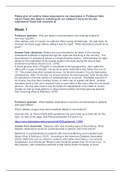Exam (elaborations)
NR566 Midterm review questions with answers (Week 1, 2, 3)
- Course
- AIT Nursing (NR566)
- Institution
- Thompson River University (TRU )
Please give all credit to these responses to my classmates in Professor Halls class!!! Hope this helps in reviewing for our midterm!! Sorry for the late submission! Good luck everyone Week 1 Professor question: Why are statins recommended in the evening instead of morning? (pg 561) Afte...
[Show more]



